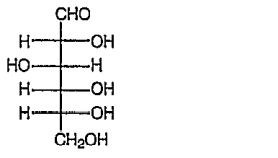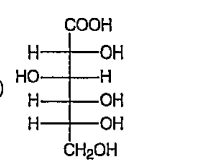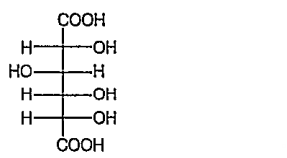Write the product formed when glucose is treated with HIO_4
The correct Answer is:A
To determine the product formed when glucose is treated with periodic acid (HIO₄), we can follow these steps:
Step 1: Understand the Structure of Glucose
Glucose is a six-carbon aldose sugar. Its structure can be represented as follows:
- The open-chain structure of glucose has an aldehyde group (-CHO) at one end and five hydroxyl groups (-OH) attached to the carbon atoms.
Step 2: Identify the Functional Groups
In glucose, the functional groups present are:
- One aldehyde group (at carbon 1)
- Five hydroxyl groups (at carbons 2, 3, 4, 5, and 6)
Step 3: Recognize the Reactivity of HIO₄
Periodic acid (HIO₄) is a strong oxidizing agent that can oxidize:
- Aldehyde groups
- Primary alcohols (1° alcohols)
- Secondary alcohols (2° alcohols)
Step 4: Oxidation Reaction
When glucose is treated with HIO₄, the following oxidation reactions occur:
- The aldehyde group at carbon 1 will be oxidized to formic acid (HCOOH).
- The primary alcohol at carbon 6 will also be oxidized to formaldehyde (HCHO).
- The secondary alcohols at carbons 2, 3, 4, and 5 will be oxidized to formic acid (HCOOH).
Step 5: Write the Products
The products formed from the oxidation of glucose by HIO₄ are:
- Formic acid (HCOOH) from carbons 2, 3, 4, and 5.
- Formaldehyde (HCHO) from carbon 6.
Final Product Summary
The overall products formed when glucose is treated with HIO₄ are:
- Formaldehyde (HCHO)
- Formic acid (HCOOH)
Glucose is a six-carbon aldose sugar. Its structure can be represented as follows:
- The open-chain structure of glucose has an aldehyde group (-CHO) at one end and five hydroxyl groups (-OH) attached to the carbon atoms.
In glucose, the functional groups present are:
- One aldehyde group (at carbon 1)
- Five hydroxyl groups (at carbons 2, 3, 4, 5, and 6)
Periodic acid (HIO₄) is a strong oxidizing agent that can oxidize:
- Aldehyde groups
- Primary alcohols (1° alcohols)
- Secondary alcohols (2° alcohols)
When glucose is treated with HIO₄, the following oxidation reactions occur:
- The aldehyde group at carbon 1 will be oxidized to formic acid (HCOOH).
- The primary alcohol at carbon 6 will also be oxidized to formaldehyde (HCHO).
- The secondary alcohols at carbons 2, 3, 4, and 5 will be oxidized to formic acid (HCOOH).
The products formed from the oxidation of glucose by HIO₄ are:
- Formic acid (HCOOH) from carbons 2, 3, 4, and 5.
- Formaldehyde (HCHO) from carbon 6.
The overall products formed when glucose is treated with HIO₄ are:
- Formaldehyde (HCHO)
- Formic acid (HCOOH)
Topper's Solved these Questions
- BOOK - CBSE COMPLEMENTARY MATERIALCHAPTER - BIOMOLECULESEXERCISE - SHORT ANSWER-I TYPE QUESTION27videos
BIOMOLECULES
- BOOK - CBSE COMPLEMENTARY MATERIALCHAPTER - AMINESEXERCISE - 5 MARKS7videos
AMINES
- BOOK - CBSE COMPLEMENTARY MATERIALCHAPTER - CHEMICAL KINETICSEXERCISE - LONG ANSWER TYPE QUESTIONS12videos
CHEMICAL KINETICS
Similar Questions
Knowledge Check
- Question 1 - Select One
What is the product formed when D-glucose is treated with Br2 water?
A B
B C
C D
D
- Question 2 - Select One
Identify the product formed when barium peroxide is treated with phosphoric acid.
ABa3(PO4)2+H2OBBa3(PO4)2+H2CBa(OH)2+P2O5+H2O2DBa3(PO4)2+H2O2 - Question 3 - Select One
The products formed when ethyl chloride is treated with silver cyanide, are _________.
AC2H5CN+AgClBCH3NC+AgClCC2H5NC+AgClDH2C=CH2+HCN+AgCl
Write the product when D-glucose reacts with conc. HNO3
View SolutionWrite the product when D-glucose reacts with conc. HNO3
View SolutionName the product formed when acetic acid is treated with sodium hydroxide solution .
View SolutionIdentify the product formed when propan-I ol is treated with Conc. H2SO4 at 413 K. Write the mechanism involved for the above reaction.
View SolutionWhich of the following is the product formed when phenol is treated with dilute nitric acid ?
View Solution


